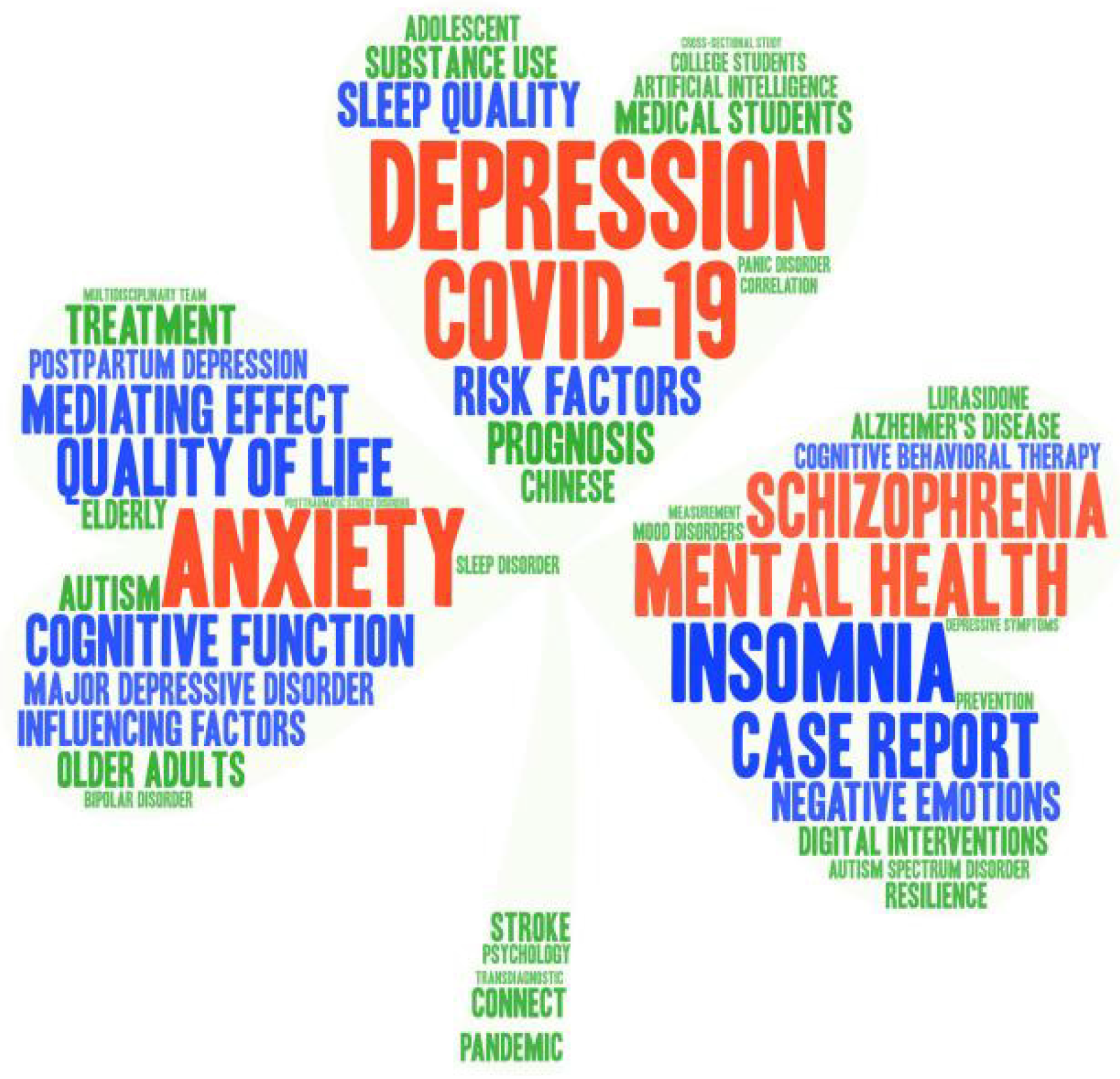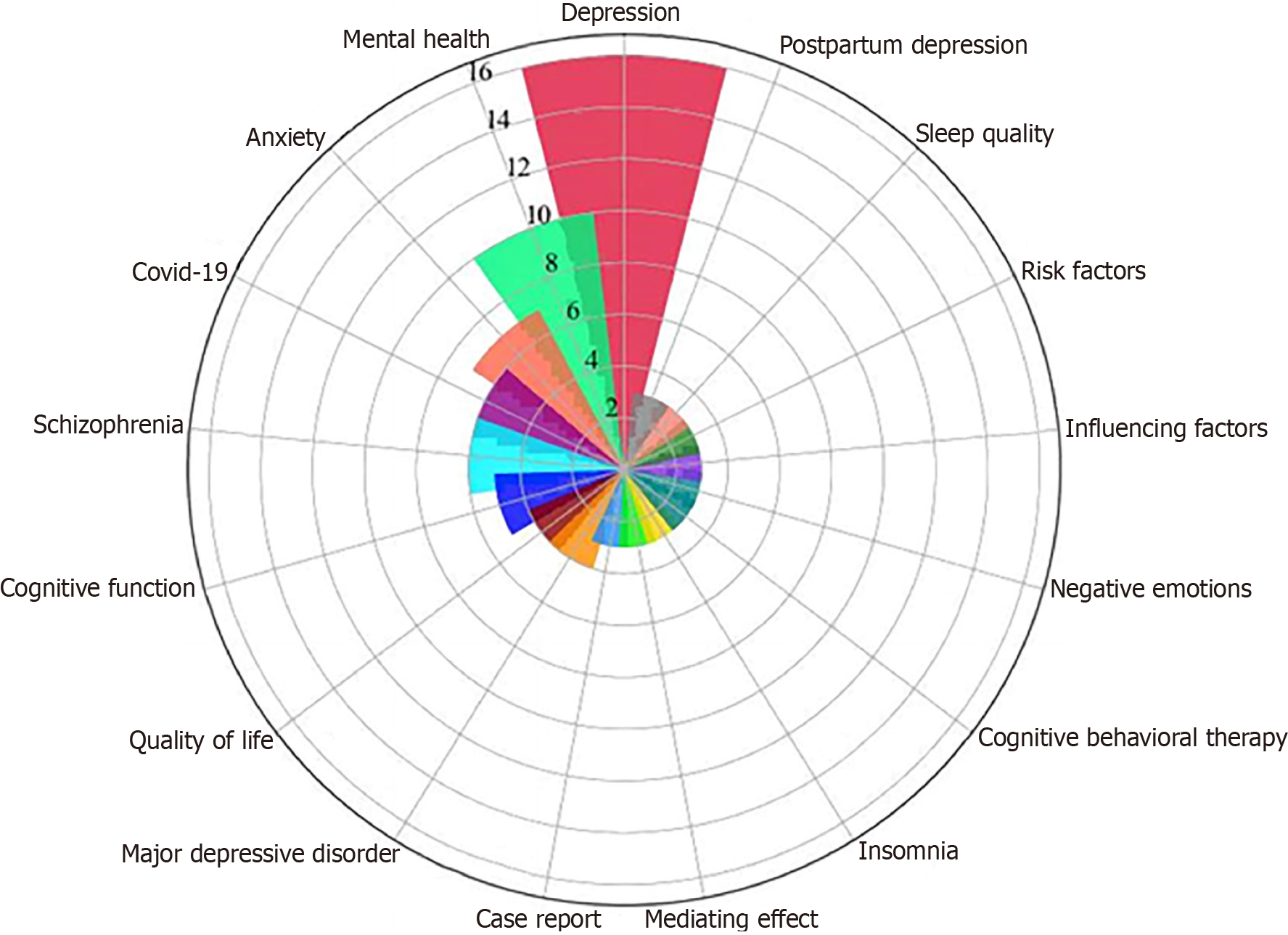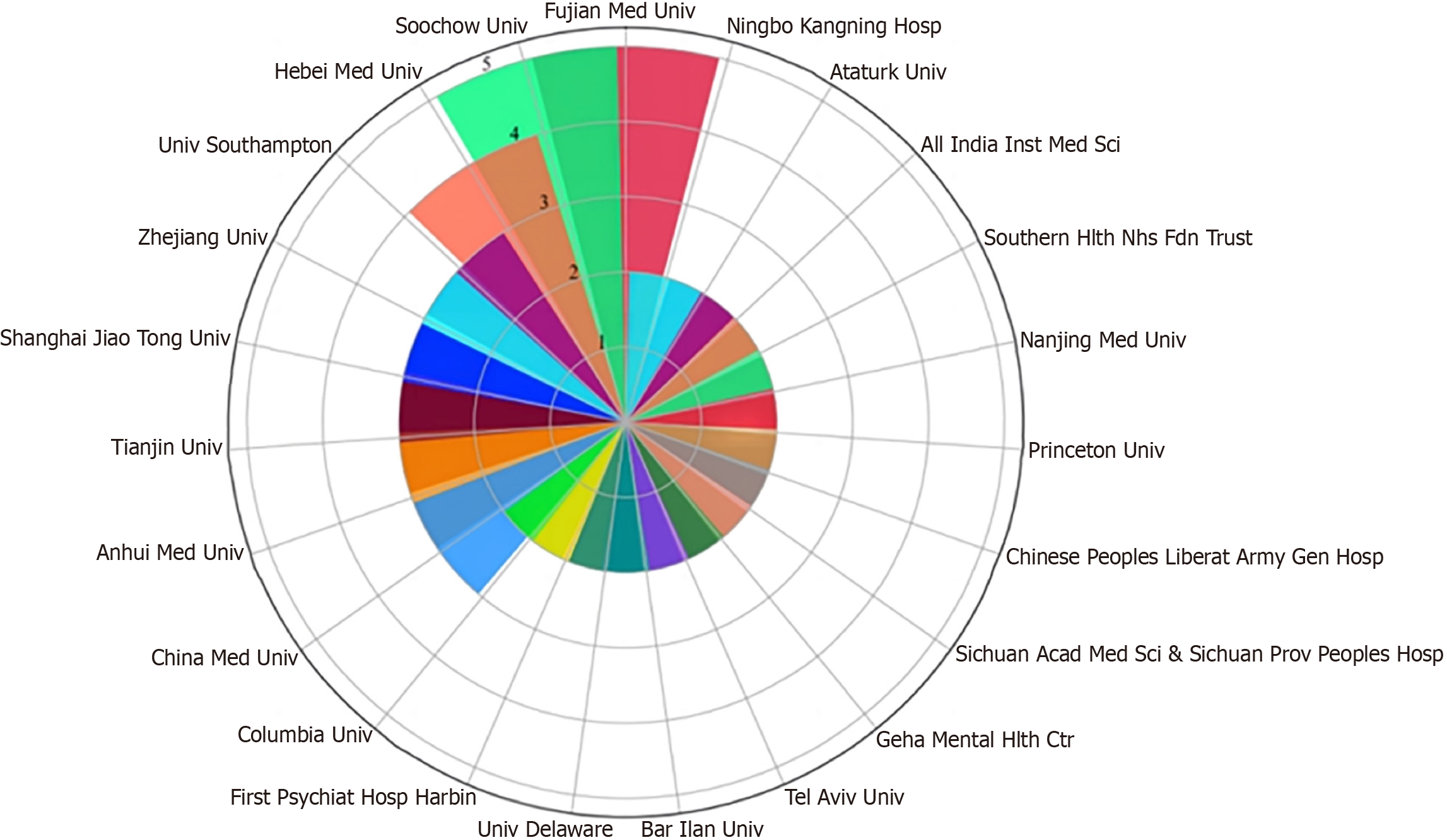INTRODUCTION
Currently, psychiatric research is undergoing a phase of dynamic transformation driven by the relentless progression of science and technology and an increasing societal concern regarding mental health issues. Within this landscape, psychiatry is facing both new challenges and opportunities. Presently, psychiatric research is making strides toward a deeper comprehension of the pathogenesis and pathophysiological foundations of various mental disorders. This progress is facilitated by interdisciplinary collaboration across fields such as neuroscience, genetics, psychology, and sociology, which has significantly advanced our grasp of the biological basis of mental health conditions and the impact of environmental factors. Advancements in neuroscience have provided invaluable insights into the intricate relationship between brain structure and function, shedding light on the neurobiological mechanisms that underlie mental disorders. This integration of modern has bridged the interest of neurology and psychiatry, further enriching our understanding of psychiatric conditions[1]. Moreover, genetic research has played a crucial role in emphasizing the significance of genetic factors in mental disorders development. In studies in imaging genetics and genomics, researchers are beginning to unravel the molecular and genetic architecture of neural phenotypes, offering insights into the neural mechanisms involved in the manifestation of genetic risks for psychopathology[2]. Additionally, contributions from psychology and sociology are substantial, as they provide valuable perspectives on individual behavioral patterns, social interactions, and environmental influences on mental health. By integrating insights from these disciplines, we can attain a more comprehensive understanding of the complexities surrounding the development and treatment of mental illness.
Furthermore, psychiatric research is progressively transitioning towards individualized and precision medicine, aiming to tailor treatments to the unique needs of each patient. This paradigm shift is fueled by advancements in genomics, biomarkers, imaging technologies, and other cutting-edge tools that enable researchers to discern nuanced biological and clinical characteristics among individuals. By leveraging these technologies, researchers can develop personalized treatment plans that enhance efficacy and outcomes. For instance, advances in genomics have provided profound insights into the genetic foundations of mental illness. Genome-wide association studies have emerged as instrumental in identifying genetic risk variants associated with complex diseases, offering valuable clues for personalized intervention strategies[3]. Biomarkers, on the other hand, provide supplementary information about diseases or interventions at various stages, from pathogenesis to recovery, aiding the customization of therapeutic approaches[4]. Moreover, neuroimaging plays a pivotal role in establishing a biological basis for psychiatric diagnosis[5]. Through sophisticated imaging techniques, researchers can detect subtle changes in brain structure and function, leading to a deeper understanding of the underlying pathophysiological processes of psychiatric disorders. This insight enables the tailoring of treatment plans to align with individualized treatment plans accordingly. The shift towards individualized medicine signifies the importance of psychiatrists viewing each patient as a unique individual, departing from a one-size-fits-all approach to care[6]. Integrating precision psychiatry into personalized treatment strategies ensures that interventions are precisely tailored to the specific characteristics and needs of each patient, maximizing therapeutic efficacy[7].
Additionally, psychiatric research is actively exploring novel treatments and interventions that extend beyond traditional pharmacological and psychotherapeutic approaches. Non-pharmacological treatments, such as psychosocial interventions, cognitive training, and lifestyle modifications, are gaining traction in the field[8-10]. These approaches aim to significantly enhance individuals’ mental well-being and improve their quality of life by addressing psychological, social, and lifestyle factors holistically. Concurrently, the landscape of mental healthcare is being transformed by advancements in digital healthcare technologies and artificial intelligence. Artificial intelligence applications are increasingly assisting in psychiatric diagnoses, symptom tracking, disease prognosis, and psychoeducation[11]. As society continues its digital evolution, the integration of artificial intelligence into psychiatry is poised to expand significantly[12].
Besides, psychiatric research is actively responding to societal changes and global challenges. The coronavirus disease 2019 (COVID-19) pandemic, in particular, has emerged as a significant threat to global mental health. Within the field of psychiatry, researchers have extensively scrutinized the pandemic’s impact on mental health and have endeavored to devise effective psychological interventions and support measures[13-15]. There is a growing acknowledgment that the relationship between mental health and illness is influenced not only by biological determinants but also by socio-cultural factors. Unlike disciplines such as cardiology or nephrology, psychiatric diagnosis and treatment are profoundly influenced by cultural and societal norms[16]. Attitudes and perceptions surrounding mental health issues can significantly affect individuals’ willingness to seek medical help and clinicians’ assessment of their condition. Therefore, psychiatric research and practice must consider the complexities of human behavior and socio-cultural contexts.
On a global scale, numerous journals are dedicated to publishing research in the field of psychiatry, with a focus on advancing psychiatric research and contributing to population health and societal development. Among these, the World Journal of Psychiatry (WJP) stands out as a high-quality, online, open-access, single-blind peer-reviewed journal published by the Baishideng Publishing Group. The paramount objective of WJP is to showcase and promote distinguished research in the field of psychiatry, to help advance development of this field. Articles published in WJP are high-quality, clinical and basic, influential research articles by established academic authors as well as new researchers. Recognizing that mapping knowledge domains serves as a powerful visualization technique capable of elucidating complex relationships such as networks, structures, interactions, and evolutions among knowledge units or clusters[17], WJP endeavors to explore trending topics, identify active authors, and address pressing issues in psychiatry. To achieve this objective, this study aims to utilize knowledge domain visualization techniques to analyze papers published by WJP in 2023. By doing so, it seeks to provide valuable references for subsequent research endeavors in psychiatry, thus contributing to the continuous development of the field.
MATERIALS AND METHODS
Data source
The study utilized the Web of Science Core Collection as the primary data source, focusing specifically on the WJP as the target journal. The publication period was restricted from January 1, 2023 to December 31, 2023, resulting in the identification of a total of 107 articles.
Procedure
For data analysis, COOC 14.3 software[18] was employed, and rose diagrams were generated. Additionally, co-occurrence analysis and cluster analysis were conducted using VOSviewer 1.6.20 software[19]. The downloaded data underwent comprehensive analysis, covering aspects such as keywords, authors, institutions, countries, and cited literature.
RESULTS
High-frequency keywords and keyword clustering
The study revealed high-frequency keywords and identified keyword clusters within the papers published in the WJP in 2023. Among the 502 keywords analyzed, 49 appeared two or more times (Figure 1), while 17 keywords appeared three or more times (Figure 2). Notably, five keywords appeared six times or more: “depression” (16), “mental health” (10), “anxiety” (7), “schizophrenia” (6), and “COVID-19” (6).
Figure 1 Word cloud of 49 keywords.
The color red indicates that the keyword occurs 6 times or fewer, blue indicates that the keyword occurs between 3 and 5 times, and green indicates that the keyword occurs twice.
Figure 2 Seventeen high-frequency keywords.
COVID-19: Coronavirus disease 2019.
Furthermore, cluster analysis of the 49 keywords revealed their classification into four distinct groups (Figure 3). The first category encompassed terms such as mental health, digital interventions, and COVID-19. Keywords related to anxiety, depression, and quality of life were grouped in the second category. The third category comprised keywords such as schizophrenia, Chinese, and medical students. Lastly, terms like influencing factors, risk factors, and mediating effect comprised the fourth category.
Figure 3
Cluster map of 49 keywords.
Authors, institutions, and countries (regions)
The study examined the authors, institutions, and countries featured in the 2023 issue of the WJP. Among the 540 authors involved, 22 authors contributed to two or more papers. Notably, five authors, namely Zhou B, Zhang Y, Mei X, Zou ZL, and Liu XQ, each authored three papers. Additionally, 17 authors, including Ferber SG, contributed two papers each (Figure 4).
Figure 4
Authors with two or more publications.
In terms of institutions, the analysis revealed the involvement of 199 institutions, with 23 of them publishing two or more papers. Leading the list were Fujian Medical University, Soochow University, and Hebei Medical University, each contributing five papers. Additionally, six institutions, such as the University of Southampton, published three papers each, while 14 institutions, including Columbia University, published two papers each (Figure 5). Additionally, the study covered 26 countries (regions), with 13 of them publishing two or more papers (Figure 6). Notably, China led with 80 publications (including two papers from Taiwan), followed by United States (5), United States (5), and Turkey (4).
Figure 5
Institutions with two or more publications.
Figure 6
Countries (regions) with two or more publications.
Cited literature
The study revealed that out of the 5181 documents cited in the analyzed papers, 77 were cited two or more times. Notably, the most frequently cited literature was the American Psychiatric Association[20], referenced five times. In terms of connection strength within the co-occurrence graph of cited literature, Kotov et al[21] had the highest connection strength (37). This literature was frequently cited in conjunction with other works such as the American Psychiatric Association[20], Caraci et al[22], and others (Figure 7). As of the time of data retrieval, 22 out of the 107 papers published in 2023 had been cited one or more times. Among them, the paper titled “Delivering substance use prevention interventions for adolescents in educational settings: A scoping review” by Liu et al[23] garnered the highest number of citations, with a total of 10 times. The following closely followed was “Kynurenine pathway of tryptophan metabolism in pathophysiology and therapy of major depressive disorder” by Badawy et al[24], cited three times.
Figure 7
Co-occurrence network of references.
DISCUSSION
This study analyzes the papers published in WJP in 2023, utilizing knowledge graph visualization to explore prominent topics, authors, institutions, and countries within the journal. Such an analysis offers valuable insights for guiding future research endeavors in the field of psychiatry. These findings contribute to the deepening of our comprehension within the field of psychiatry and further the advancement of research in this domain.
The findings of this study highlight the prevalence of keywords such as “depression”, “mental health”, “anxiety”, “schizophrenia”, and “COVID-19” within the WJP in 2023, underscoring their significance in psychiatric discourse. Notably, “depression” stands out as the most frequently occurring keyword, indicating its prominence in research discussion. Researchers have approached the topic of depression from various perspectives, as evidenced by multiple studies. For instance, cross-sectional surveys have explored interventions aimed at mitigating depression by reducing excessive smartphone usage and enhancing sleep quality[25]. Besides, investigations have delved into the clinical characteristics and the connection between posttraumatic stress disorder and trauma-induced depression, along with their potential treatments[26]. Additionally, studies have provided a comprehensive overview of the growth patterns, trends, and research themes concerning dialysis and depression[27].
Further investigation has revealed that the keywords found in the 2023 papers of WJP can be categorized into four distinct groups. In the first category, keywords such as mental health, digital interventions, and COVID-19 emerged prominently. Throughout 2023, several studies persisted in investigating mental health issues within the context of the novel coronavirus pandemic[28,29].
Mental health has always been an important area of psychiatric research[30,31]. It can be anticipated that mental health research will continue to garner attention. Category 2 encompassed keywords such as anxiety, depression, and quality of life. Notably, anxiety and depression frequently appeared together as keywords[32,33]. Keywords in category 3 comprised schizophrenia, Chinese, and medical students. Schizophrenia remained a focal point of research interest in 2023[34,35]. Lastly, category 4 included terms such as influencing factors, risk factors, and mediating effects. Papers in this category focused on elucidating various “factors”[36,37]. In addition to these categories, two papers garnered significant attention from psychiatry researchers. One of these papers, authored by the American Psychiatric Association[20], presented a diagnostic and statistical manual on mental disorders. The other paper, by Kotov et al[21], posited that traditional taxonomies suffer from limited reliability and validity due to arbitrary boundaries between psychopathology and normality, unclear distinctions between disorders, frequent comorbidity among disorders, inherent heterogeneity within disorders, and diagnostic instability. Consequently, the study proposed the Hierarchical Taxonomy of Psychopathology model.
This study also revealed that among the 540 authors featured in the 2023 issue of the WJP, five authors (Zhou B, Zhang Y, Mei X, Zou ZL, and Liu XQ) exhibited considerable activity. Notably, the most cited paper was authored by Liu et al[23], which, as a scoping review, delved into the types, characteristics, and effectiveness of substance use interventions in educational settings for adolescents. It is widely recognized that the involvement of prolific authors significantly bolsters the reputation and impact of a journal. When esteemed scholars opt to disseminate their research through a particular journal, it inherently attracts a broader readership and garners attention from fellow academics. Hence, journals should proactively solicit submissions from such active authors within the field to augment the competitiveness and allure of the publication.
Moreover, regarding the affiliations of authors and their respective countries (regions), the notable institutions with a higher volume of published papers include Fujian Medical University, Soochow University, and Hebei Medical University. Similarly, the countries contributing to a greater number of published papers are China, United Kingdom, and United States. In future research endeavors, it is imperative to strengthen collaborations between research institutions and foster international cooperation. Such collaborative efforts facilitate resource, data, and knowledge sharing, thereby advancing scientific progress. Moreover, these collaborations contribute to the development of more comprehensive and productive solutions for the prevention, diagnosis, and treatment of mental illnesses.
This study has a few shortcomings. Firstly, while the mapping of knowledge domains was employed in this study, only literature published in 2023 was analyzed. Future studies could consider including literature from different time periods for a more comprehensive analysis. Secondly, the primary literature selected for this study was published in the WJP. For future research, it is recommended to select multiple psychiatry-related journals to analyze research trends and hotspots in psychiatry from a broader perspective.
CONCLUSION
In 2023, keywords such as depression, mental health, anxiety, schizophrenia, and COVID-19 were notably prevalent in papers published in the journal WJP. These papers predominantly centered around four key areas: Mental health, depression and anxiety, schizophrenia, and related factors. Moreover, a substantial number of papers originated from authors based in countries such as China, United Kingdom, United States, and Turkey. In terms of citation frequency, Liu et al[23] emerged as the most cited paper, indicating its significant impact within the field. In addition, the American Psychiatric Association (2013) was the most frequently referenced source among the cited literature in published papers. Moving forward, this journal must maintain its commitment to enhancing the quality of papers within the realm of psychiatry. Additionally, exploring the integration of digital interventions and artificial intelligence within the field presents promising avenues for advancing research and improving clinical outcomes.
ACKNOWLEDGEMENTS
We extend our sincere gratitude to the authors of each of the papers included in this study.
Provenance and peer review: Invited article; Externally peer reviewed.
Peer-review model: Single blind
Specialty type: Psychiatry
Country of origin: China
Peer-review report’s classification
Scientific Quality: Grade C
Novelty: Grade B
Creativity or Innovation: Grade B
Scientific Significance: Grade B
P-Reviewer: Kar SK S-Editor: Wang JJ L-Editor: A P-Editor: Zhang L



















